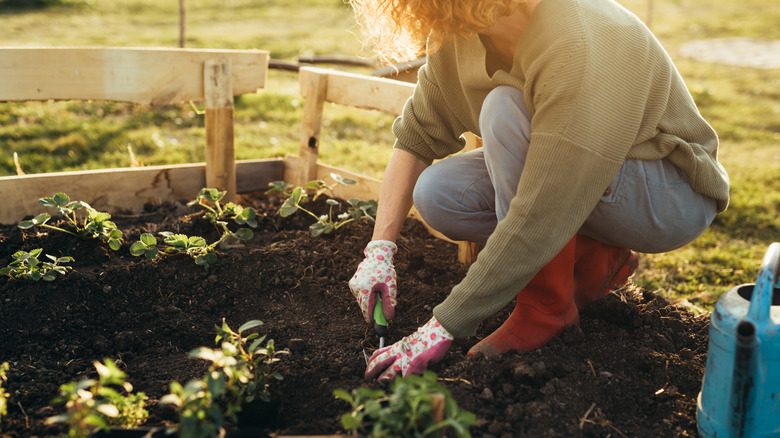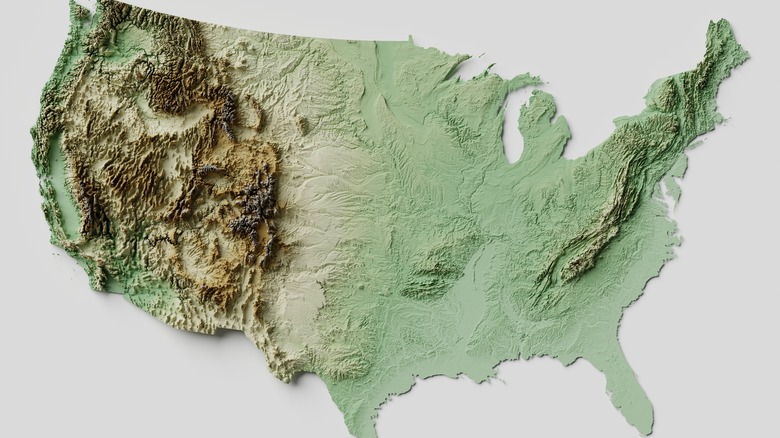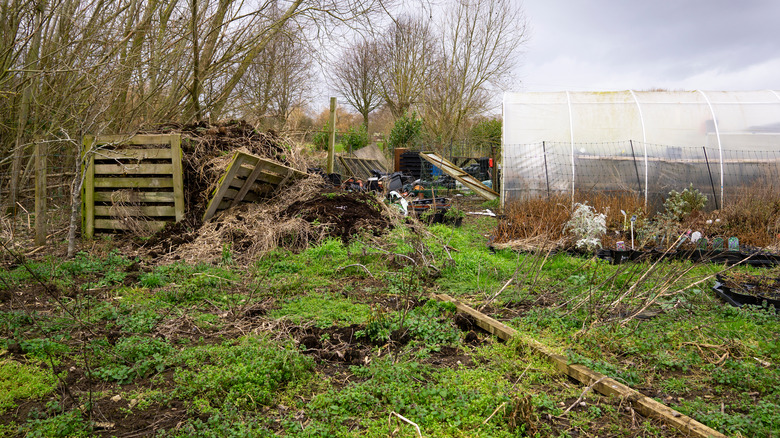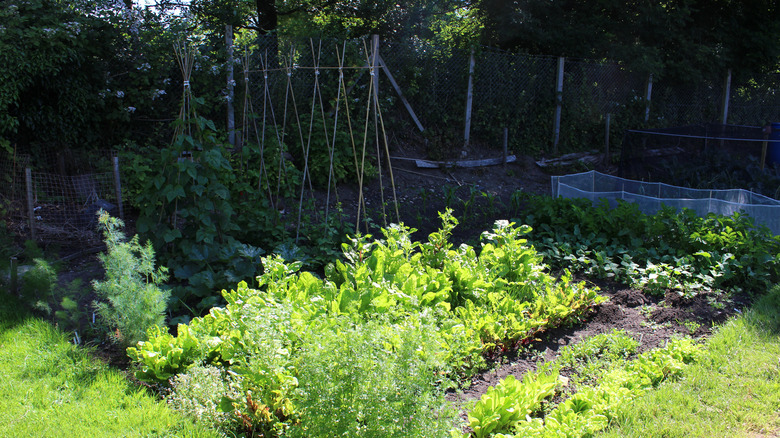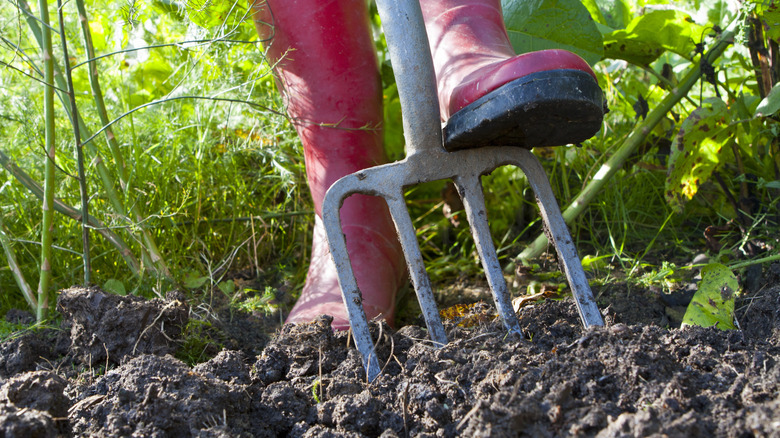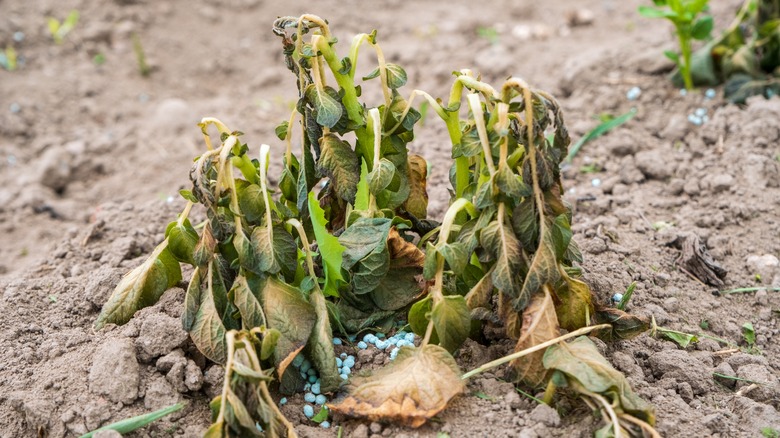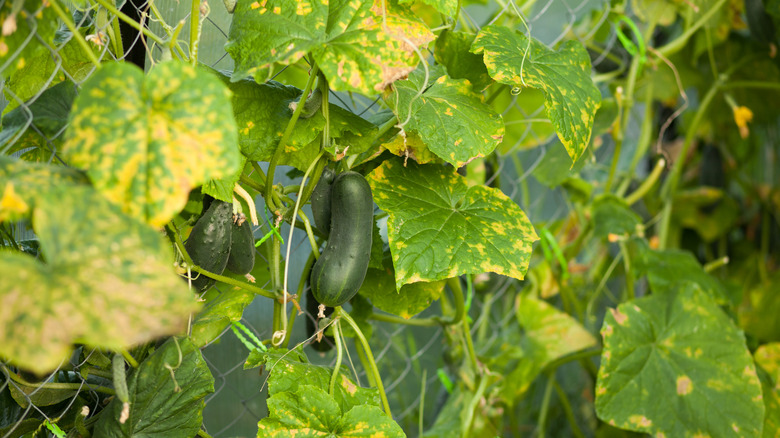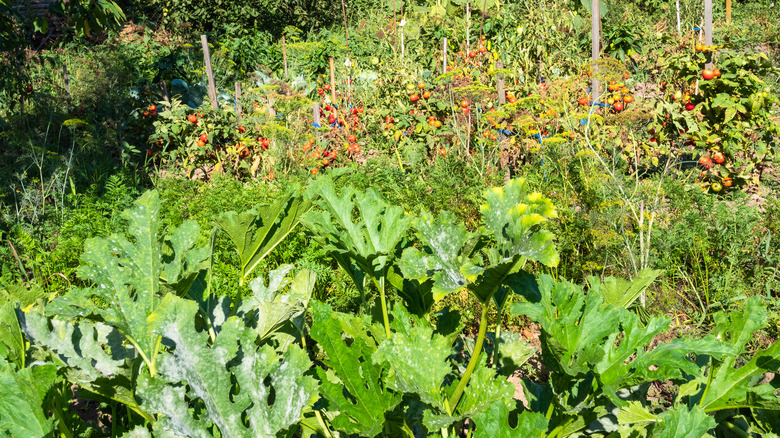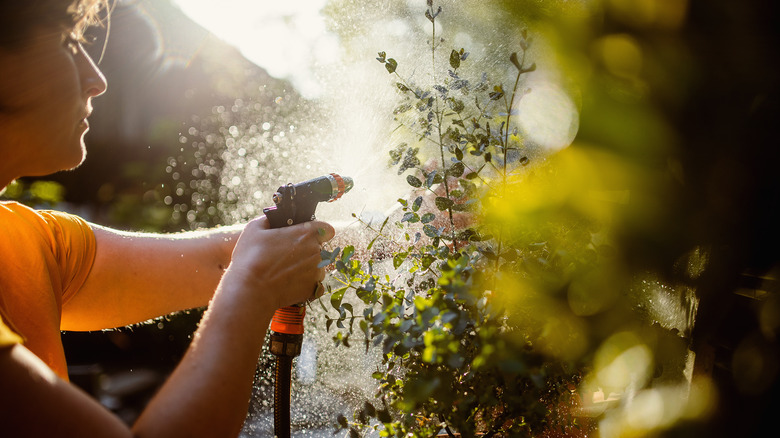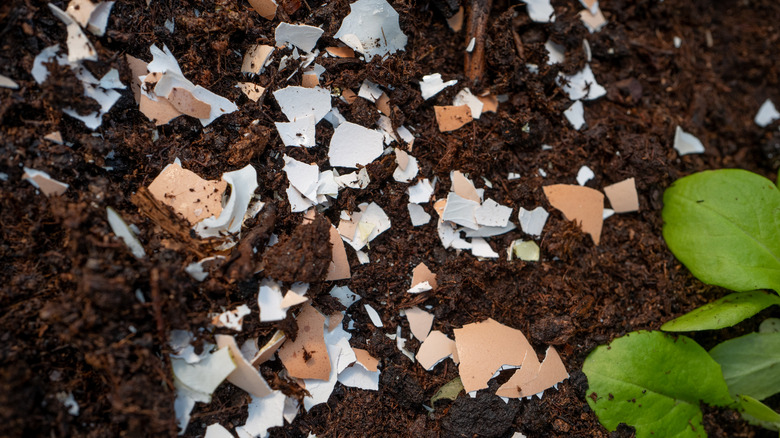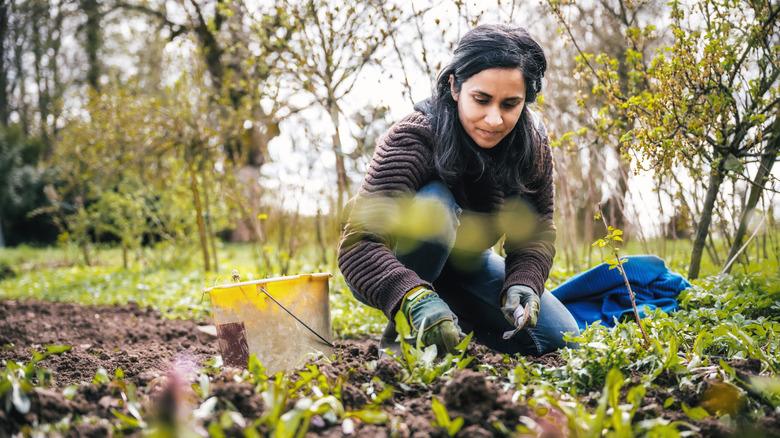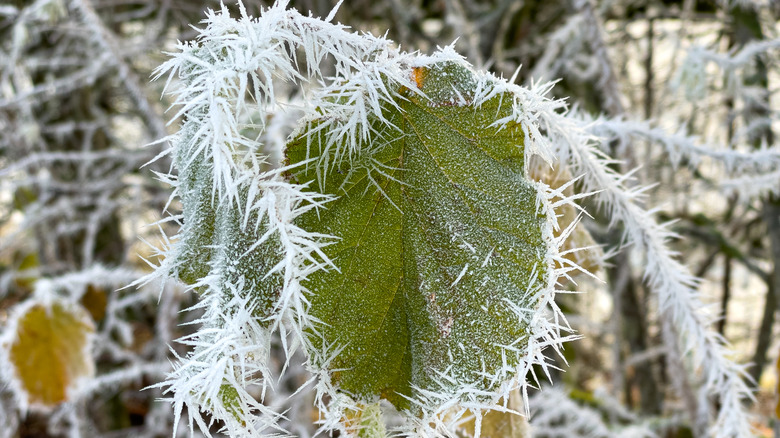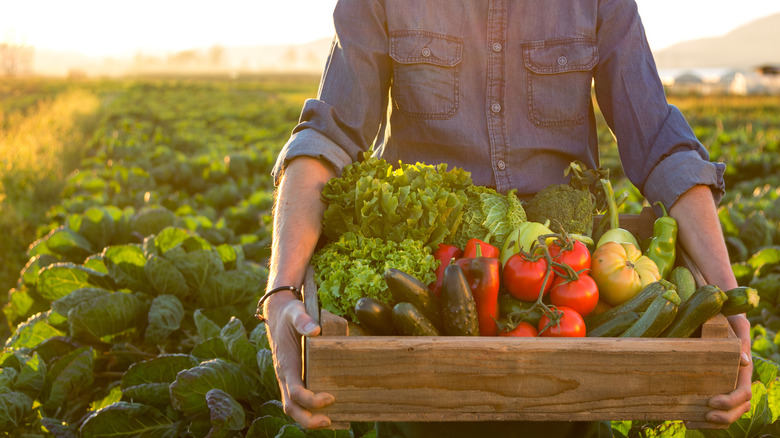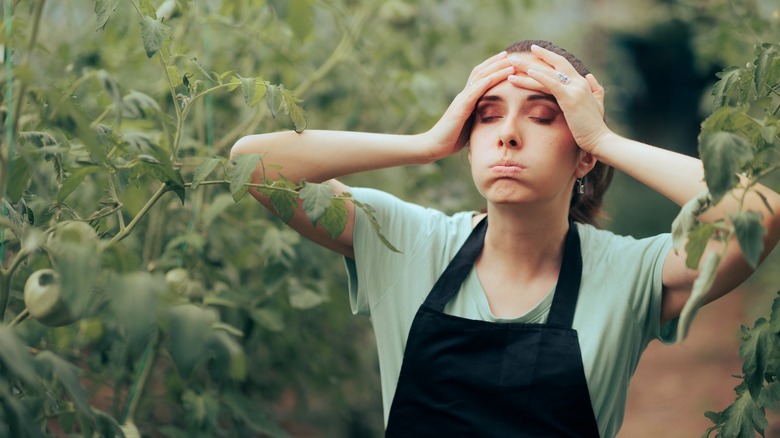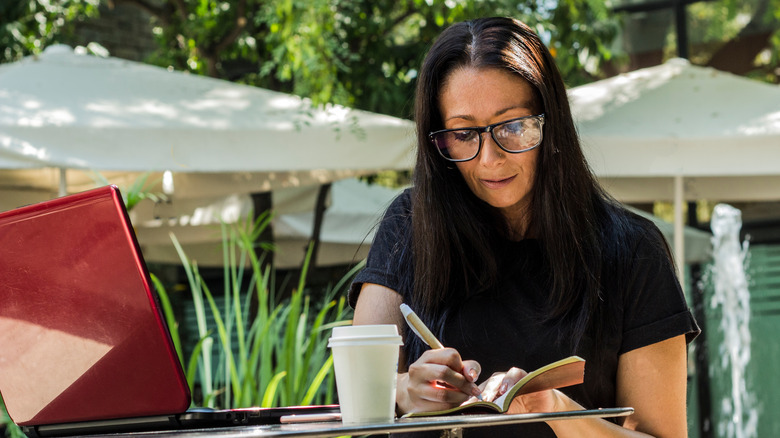16 Mistakes Beginning Gardeners Make Way Too Often
All gardeners need to start somewhere. Even though humans have been cultivating plants for food and pleasure for thousands of years, getting your own plot started comes with no shortage of learning curves. No one is perfect right off the bat, and beginning gardeners are bound to make several mistakes during their gardening journey. However, there are certain mistakes that are committed way too often and can set fledgling gardens up for failure. The good news is that all of them can be avoided or remedied with a little research and added effort.
Now, we don't want to give the impression that starting your own garden is impossible. In fact, once you get past the initial hurdles of purchasing seeds, preparing soil, planting, feeding, and harvesting your crops, gardening can be nothing short of joyous. Learning from your mistakes at the start is only going to help make your future gardening efforts all the more successful.
So, whether you've planted your seeds too early (or too late), picked the wrong spot for your garden, or failed to properly prepare your soil, you can rest assured that these 16 mistakes beginners make way too often won't spell doom for your life as a gardener.
Not knowing your hardiness zone
The United States is geographically, geologically, topographically, and meteorologically diverse. Growing conditions change from state to state, and from region to region within states. Because of this, it can be difficult to determine what crops, fruits, and flowers grow best in your specific area. But how exactly do you know what growing conditions your region has? If you live in the United States, the USDA has a map you will definitely find useful.
The United States Department of Agriculture has divided the Lower 48, Alaska, Hawaii, and Puerto Rico into 26 specific hardiness zones. The zones are labeled 1a and 1b (coldest) through 13a and 13b (hottest). Hardiness zones are determined by the lowest winter temperatures from year to year. The zones are split into the a and b to differentiate 5 and 10 degree Fahrenheit differences between areas. Gardeners can use the map to determine what kind of plants will work well in their own hardiness zones.
If gardeners fail to know their hardiness zones, they run the risk of planting perennials and annuals that will not survive. This is very important when it comes to perennials, as they are planted once and expected to survive for years to come. Seed packets will come with indications of whether or not the plant in question will grow in a hardiness zone. This is one of the first things beginner gardeners should check before they even consider planting.
Putting your garden in the wrong place
This is a two pronged mistake. Putting your garden in the wrong place, primarily, means that you are placing it out of sight and out of mind. Essentially, you're putting the garden too far away from your house. Putting the garden in a far off corner of your yard makes it far harder to prioritize. And if you're not making your garden a priority, why bother having one?
You need to put your garden in a space where it is going to be seen every day. This is a practice that practitioners of permaculture call "Zoning." The idea is that you put the things that require daily attention closest to your house, thereby making it Zone 1. Like hardiness zones, planning zones differ from property to property. Some plant their gardens within view of the kitchen window, while others plant them right in the front yard. The more you see your garden, the more you're going to work on it.
Yet, there is more to where you choose to plant your garden than simply putting it in a place where you see it every day. You need to pick a spot for your garden where your plants will actually grow, which is the whole point of gardening in the first place.
Planting your garden in a spot without much sun
The second prong of this garden placement fork is that of planting your garden in the wrong spot. Now, there are certain plants that thrive in the shade, such as hostas, bleeding hearts, and hydrangeas. If you are planning on getting a garden prepared for growing vegetables, however, you are going to need to find an area on your property that has a good amount of sun.
Planting that vegetable garden next to a large grove of trees, or in a particularly shady area of your yard is a surefire way to stunt its growth. The vast majority of vegetables grown for food require at least 3 to 6 hours of sun in order to thrive properly. Tomatoes and peppers, in particular, are sun-loving plants.
If this comes into conflict with your zoning area, you might need to re-work your plan in order to find a spot that gets the best sun for your plants. However, there should be plenty of areas in your yard that get enough sun for your garden to succeed.
Failing to prepare soil
The perfect garden spot is going to mean absolutely nothing if you don't prepare the soil. Plants cannot just be planted in any old soil, because not all plants thrive in the various soil types that can litter a property. In order for vegetables to grow properly, they should be planted in well-fed, well-watered, soft, aerated ground. There they will thrive.
For the beginning gardener, the biggest hangup of actually getting started is the work that goes into preparing soil. There are several approaches one could take to this. There are various camps debating whether or not ground should, or should not be tilled. However, the method you choose is ultimately going to be the one that is best for you, and best for your plants.
Preparing your solid begins by understanding the type of soil you're working with. This can be done by getting your soil tested, which you can get done professionally or do it yourself. Once you've decided where you are going to plant, you will need to work the soil with various natural fertilizers and amendments like diatomaceous earth, compost, minerals, peat, manure, and nutrients. Do not skip this step. You cannot just plant things in the ground and wish for them to grow.
Planting too early
Now, there is something to be said for the excitement of beginning your first garden. If you've done all the prep work, those seeds you bought are going to be eying you, and begging to be planted. It's time! You're ready to go. But not so fast there, slugger. You're not ready to plant just yet. Take a look at your calendar and see why.
Planting your seeds too early in the season is a classic rookie gardening mistake. If you plant your seeds in the ground too early, you open them up to a whole host of potential risks. One of the biggest is frosts. Apart from the risk of frosting, soil needs time to properly warm up if it is going to properly take seeds. If the soil is still too cold, it can inhibit root growth. What this means is that if the roots are not properly set in the ground, the plant won't be getting enough to eat, which can lead to any number of diseases and also prevent the vegetables from fruiting properly. Most summer vegetables need soil that's between 55 and 65 degrees Fahrenheit to thrive.
Planting too early can also lead to wilting and foliage necrosis. So, hold off on that urge to put those seeds in the ground too early. You'll be rewarded for your patience.
Planting too late
The other side of this planting coin is planting your seeds too late in the season. Doing this could spell disaster for certain plants in your garden. This is especially true if you are planting food in the height of summer. The plants could become too stressed thanks to the intense heat, which could actually stunt their growth, and affect the harvest. Couple that with planting too close to your frost date, and you have the perfect pairing of weather issues that will keep your garden from thriving.
Now, anyone reading who has gardened before knows that, in truth, there is no time too early or too late to plant something. Herbs can be grown year round in pots indoors with proper lighting, seedlings will germinate under grow lights, and certain vegetables can continue to thrive well into the winter in the comforts of a greenhouse.
However, this implies that the beginning gardener has all of that infrastructure in place to make planting at any time of year work. Most do not. Therefore, keeping the planting inside of a specific time window is your best bet towards ensuring a good first growing season and eventual harvest of your vegetables.
Overplanting
Just as your house can feel too crowded during the holidays, causing you to feel squeezed and suffocated, the same is true with plants. Though the urge to plant as many vegetables as possible is palpable on your first go around as a newbie gardener, these longings need to be withstood. Overcrowding your garden beds with too many plants is a very real issue that a lot of beginners make as first-timers.
The primary reason not to do this is because too many vegetables crowded in one area is going to cause them to be undernourished. This is because they will be competing for nutrients from the soil around them and will therefore not be able to grow to the proper sizes that they normally would. An overcrowded garden also leads to issues when it comes to pests, diseases, harvesting, and keeping weeds at bay. If you cannot see the soil beneath your veggie patch, it's very likely overcrowded and not getting the nutrients it needs in order to thrive.
The key to preventing this as a new gardener is to understand spacing. Different plants require different spacing, so consult some gardening guides to make sure that you're planting your vegetables the correct distance apart.
Planting too far from water
Water is vital to a fledgling garden. Yet, a lot of beginners make the mistake of planting their garden too far away from a water source. This goes hand in hand with the idea of keeping your garden in a place where you will be able to see it and tend to it daily. While you cannot control where your water sources are coming from unless you've built your house or invested the time to install extra water lines in your fields, make sure that you are planting your garden, or gardens, in spots that are easily accessible by your hose hookups.
There is nothing more tiring and aggravating than having to haul a heavy hose, or several watering cans, to a garden that is planted too far away. Keeping the garden close to your hose lines means that you will be more likely to water the garden when you're supposed to. And while you don't need to water it every day, putting it where the water is difficult to reach could cause you to simply forget to water the garden, leading your plants to wilt, dry up, and die.
Not feeding your plants
Water is not the only food your plants need over the course of the growing season. Many beginning gardeners will simply leave feeding at watering alone, and not offer their plants anything more in the way of food. Now, just like people, plants need to be fed in order to thrive. A lot of this happens in the site prep, when you're adding nutrients and natural fertilizers into the soil, but it should also happen while the plants are growing in order for them to continue thriving.
This could be a number of different things. Many times, chemical fertilizers and sprays are utilized to help plants along and keep pests off of them while they are growing. However, for the more organically minded, natural plant foods like diatomaceous earth, egg shells, compost tea, mulch, and a host of other non-chemical methods are excellent ways to keep your plants happy and fed over time.
This doesn't have to be a daily process, mind you. If you've tended to the soil beforehand, the less you will have to feed the plants during growing, as they are already getting all of the nutrients they need from the ground. Still, weekly feedings or sprays are not a bad way to continue to keep your plants fed without overfeeding them and causing them to get smothered.
Failing to weed
Weeds. The ultimate enemy of gardeners. There are many who only do container gardening specifically because of the fact that direct sown crops require weeding. It is a strenuous, aggravating task that no gardener, no matter what they say, enjoys. However, it is a necessary task because once weeds take hold, they can do some serious damage to your garden.
Weeding goes far beyond the simple desire to have gardens look neat and tidy. It keeps them from encroaching on your vegetables, choking them out, and preventing them from growing as they should. If beginner gardeners see a weed, it needs to be removed from the ground then and there. Failing to remove weeds at the proper time will cause them to run rampant throughout the garden.
Now, there are certain gardening methods that will greatly reduce weeds. One such method is the Back to Eden gardening method practiced by master gardener Paul Gautschi. He stresses the notion of utilizing layers of wood chips to both nurture the garden, and keep weeds from cropping up because they cannot fight through the mulch. It is a method that, if implemented correctly, will yield fantastic results.
Not knowing your frost dates
This goes hand in hand with plating too early or too late, as well as having an understanding of your specific USDA hardiness zone. A frost date is the first and last estimated dates when the first light freeze is expected in the fall, and the last light freeze is expected in the spring. These dates change on a yearly basis, but they're usually around the same time of year, depending, again, on your hardiness zone. Alaska's first frost is far earlier than that of South Carolina.
If you're planning a garden for the first time, memorize these dates! They will give you an idea of the timeframe you have for planting and harvesting your garden. This is especially important for beginning gardeners who don't necessarily have the infrastructure in place to over winter plants. Plus, nothing kills gardens, and confidence, quite like a good frost.
Frost can easily kill seedlings, and more warm weather loving plants like tomatoes and peppers. So, planting within your frost dates are the best ways to help you along the path to a successful first garden.
Failing to harvest
This may seem like a silly thing to say, but failing to harvest ripe produce is actually a mistake many gardeners, beginner or otherwise, make. If you do not harvest plants, the energy of the plant continues to go towards ripening that vegetable. This eventually leads to over ripening and rot, which causes the vegetable to die. By harvesting the plants and pruning the vegetables, you allow more energy to be used for producing more vegetables on the plant.
So, once the vegetable is ripe, or nearing ripeness, pick it. This is especially true with any kind of vine veggie, like tomatoes, beans, peppers, and squash. Again, the more you pick and prune, the more the fruit will blossom and grow.
Overall, this isn't too big of a mistake to make. However, if you don't harvest your vegetables, then what really was the point of planting your garden in the first place?
Being afraid to fail
This is more psychological than anything else, but a big mistake beginner gardeners make is being too afraid to start a garden in the first place. We know we've just presented a whole list of practical mistakes that rookies make at the start of their gardening careers, but don't think of those as reasons not to start gardening at all. Think of them instead as learning opportunities.
You need to be prepared for the fact that you will make these listed mistakes, and many more, during your first few seasons of gardening. Even many pro gardeners make mistakes that lead to crop failure. However, through all of that comes the chance to learn. Once a mistake is made that results in garden failure, it is seldom made again, if ever.
So don't be discouraged by the possibility of failure. It is going to happen one way or another. How you handle that is a mark of character, and a mark of how you will proceed with your gardening efforts in the future. But don't be too afraid to start just because you're worried you might mess up. Not starting is more a mistake than some poorly pruned pumpkins.
Not using resources
A great way to keep from making costly mistakes, however, is to utilize resources. One of the biggest mistakes any beginner gardener can make is not to use the literal thousands of resources at their disposal. This is particularly true of those who are afraid to start gardening. There is so much information out there for you to use. You just need to use them as they are meant for: as teaching tools.
There are books, videos, documentaries, blog posts, and articles available at your fingertips through the internet and local libraries. On the interpersonal front, friends, family members, and local gardening clubs are fantastic, hands-on approaches to learning how to garden well.
Now, there is the possibility of getting too much information. Overload can cause you to be bogged down in overwhelm and prevent you from actually getting started. So, be selective in your approach. Find voices in the gardening world that you connect with, and stick with them. See if their methods work for you. If they do, fantastic! You've found a resource you can go back to again and again.
Being too ambitious
Now, let's say you have all your resources in place and you are feeling incredibly confident about this first whack at gardening. You're so excited that you go out and buy all the seeds you can fit in your hands and plant every single one of them in your garden. They do well throughout the season, but once harvest time hits, you find your kitchen so crowded with vegetables, and more coming in every day, that you just become overwhelmed. This is what happens if you set too lofty of a goal for your first gardening season.
We're not at all saying that you cannot dream, but keep it in check. Becoming overwhelmed with the amount of work that goes into maintaining a large garden, especially if things don't go well, is a surefire way to kill the spirit. Great gardens are built over time with care and patience. Little by little, fledgling efforts become the large garden you have in your imagination.
But, it is important to have a vision. If your dream is to one day have an enormous garden from which you feed yourself, your family, and your community, visualize that goal and figure out a way to get there.
Not having a plan
The greatest way to avoid loftiness and over ambition is to come up with, and write down, a sensible plan for your garden. You are not going to get the enormous garden of your dreams right off the bat. Things take time and careful planning to grow, both in the ground and in your imagination. Think of your plan as insurance and comfort for when things start to get overwhelming. Simply look back at your plan and note that you have things under control.
What does doing this look like? Well, it is different for every gardener. Make lists, drawings, and the like. Begin to envision your garden, humbly at first, but growing over time with each successive year. Not making a plan could leave you lost with what needs to be done in the garden over the season, and how to best prepare it for the next one.
Understand that these listed mistakes, though made with frequency, should not stop you from pursuing your dream of growing vegetables, fruit, and flowers. If gardening is in your heart, pursue it with as much passion as you can muster. Use this list as a way of avoiding early pitfalls and as something that will really help you kick off your gardening journey right.
